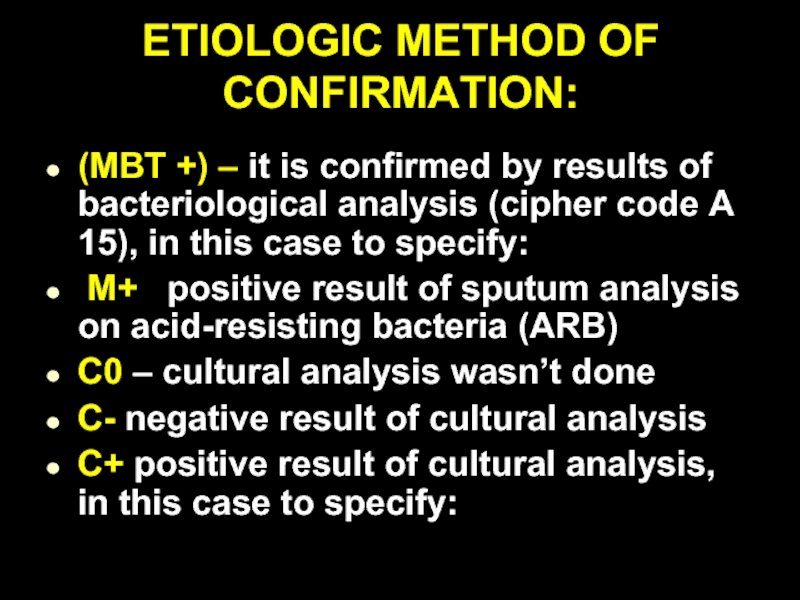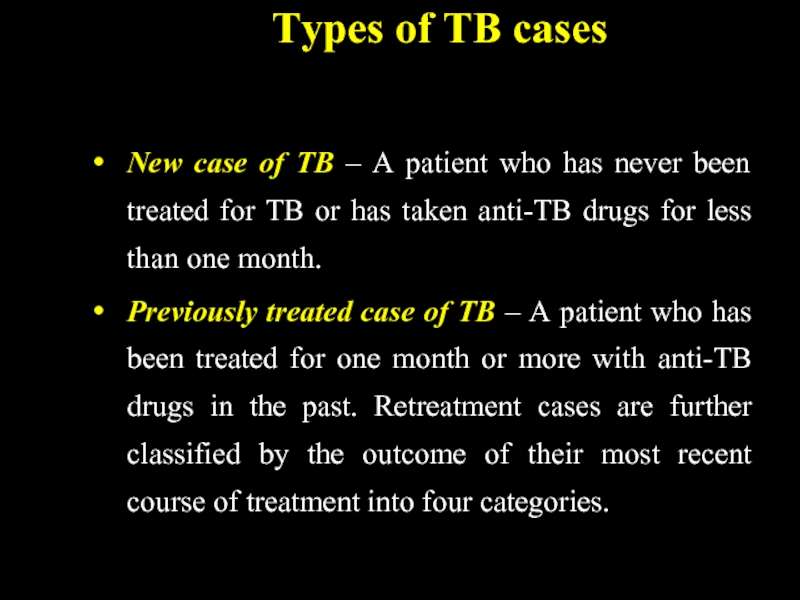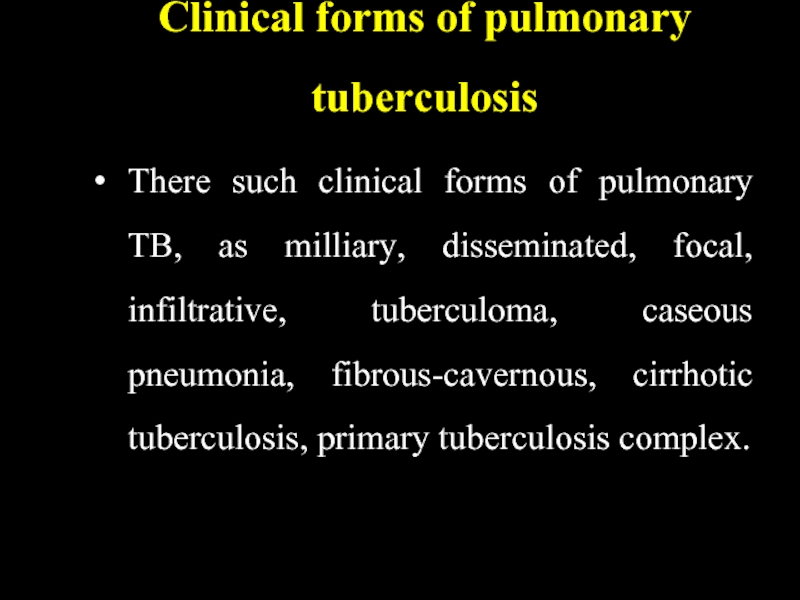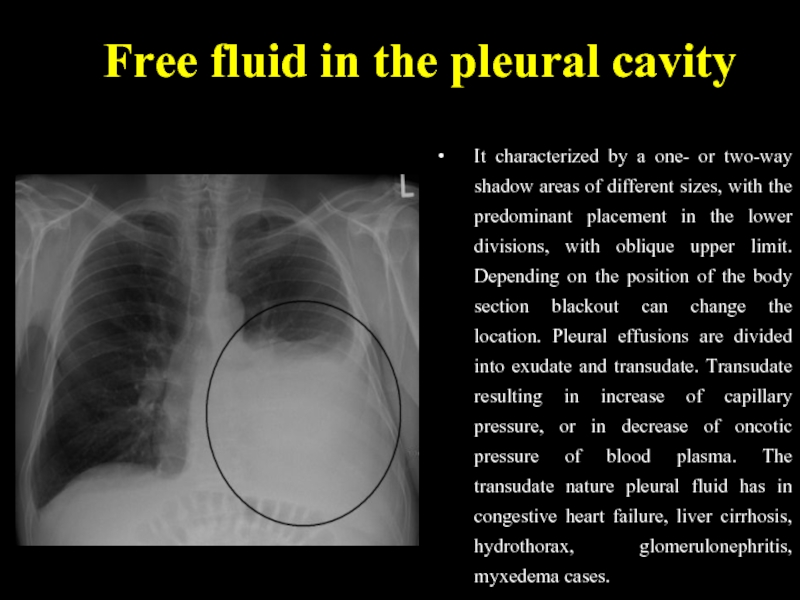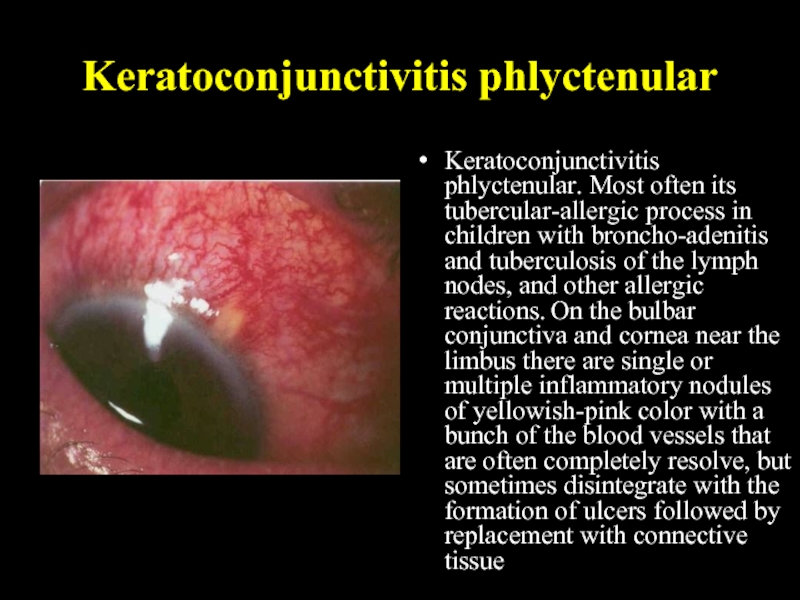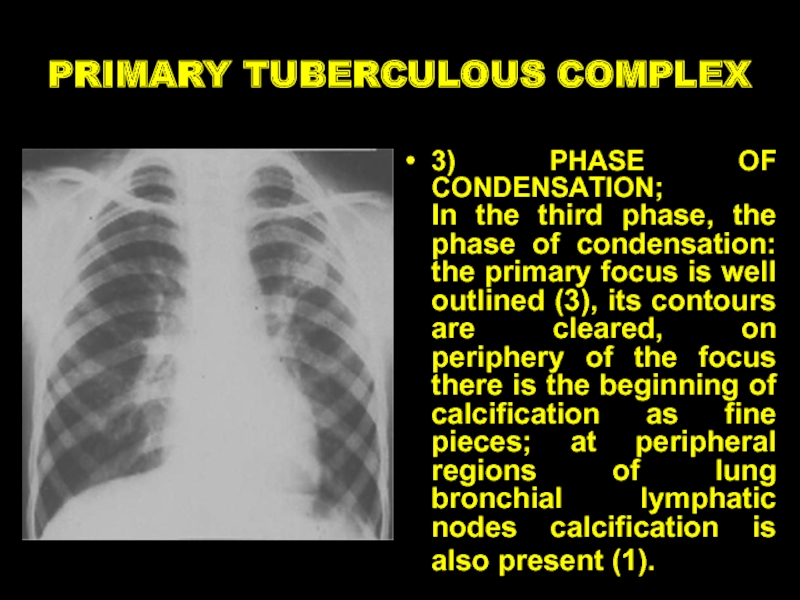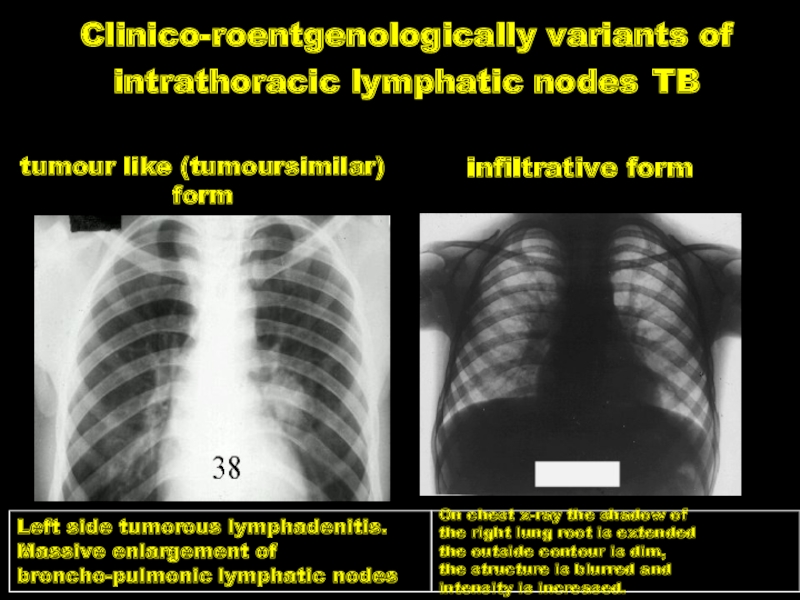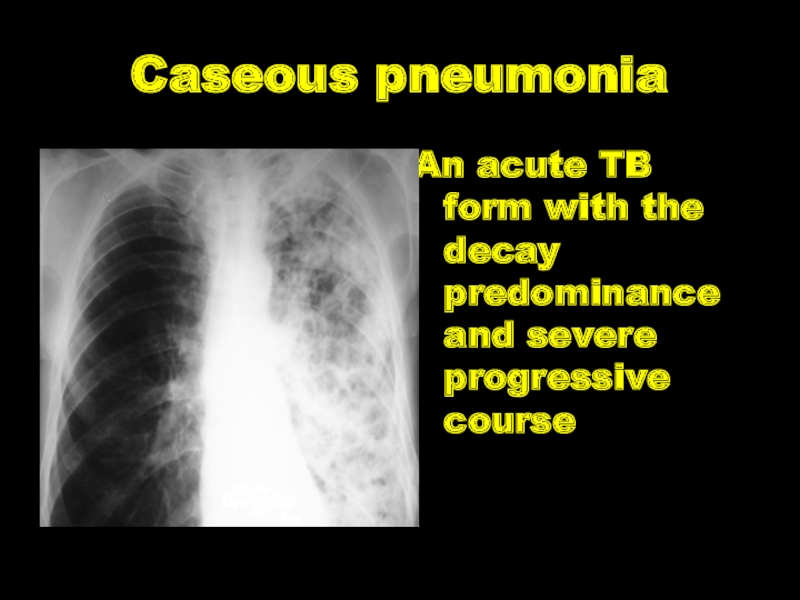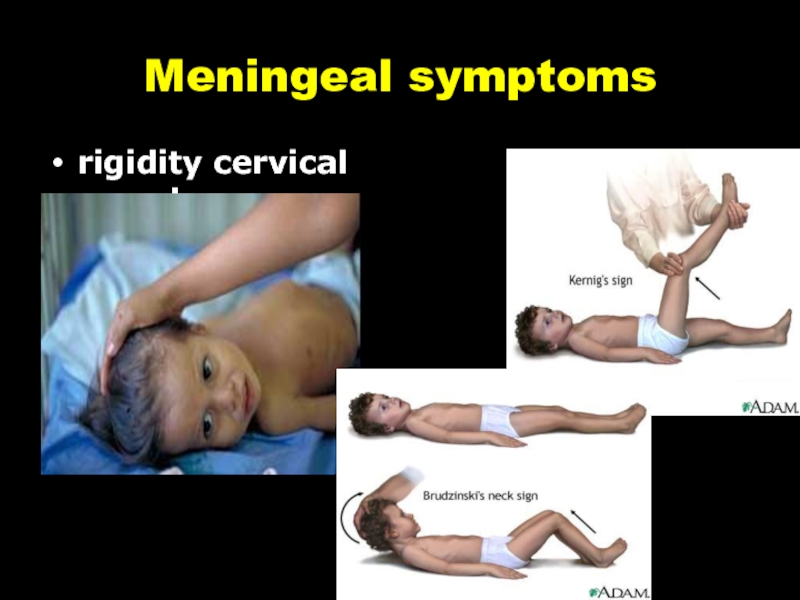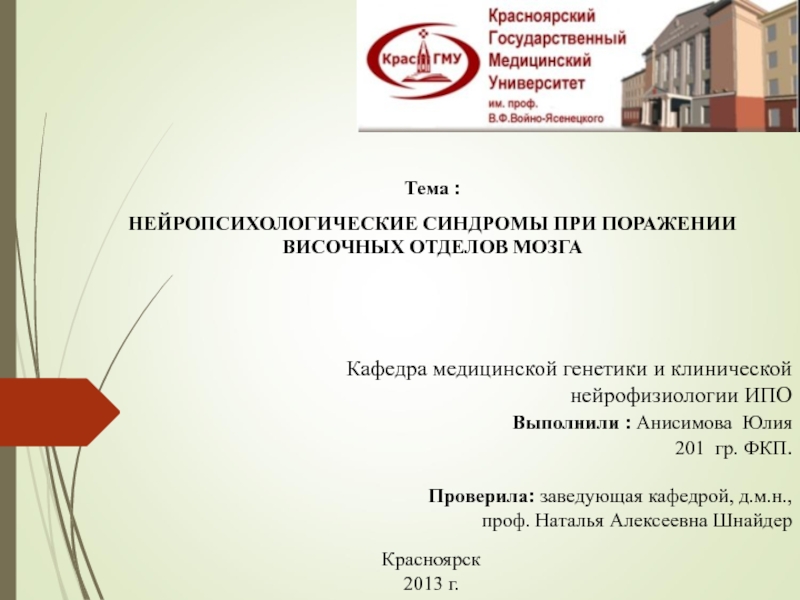- Главная
- Разное
- Дизайн
- Бизнес и предпринимательство
- Аналитика
- Образование
- Развлечения
- Красота и здоровье
- Финансы
- Государство
- Путешествия
- Спорт
- Недвижимость
- Армия
- Графика
- Культурология
- Еда и кулинария
- Лингвистика
- Английский язык
- Астрономия
- Алгебра
- Биология
- География
- Детские презентации
- Информатика
- История
- Литература
- Маркетинг
- Математика
- Медицина
- Менеджмент
- Музыка
- МХК
- Немецкий язык
- ОБЖ
- Обществознание
- Окружающий мир
- Педагогика
- Русский язык
- Технология
- Физика
- Философия
- Химия
- Шаблоны, картинки для презентаций
- Экология
- Экономика
- Юриспруденция
Primary and secondary tuberculosis. (Lecture 5) презентация
Содержание
- 1. Primary and secondary tuberculosis. (Lecture 5)
- 2. CLINICAL FORMS TB of respiratory organs
- 3. CLINICAL FORMS TB of exstrarespiratory organs TB
- 4. CHARACTERISTIC OF TUBERCULOUS PROCESS Localization and
- 5. ETIOLOGIC METHOD OF CONFIRMATION: (MBT +)
- 6. (Resist 0) MBT resistance to preparations of
- 7. Types of TB cases New case
- 8. Previously treated case of TB 1.
- 9. Case of multidrug-resistant TB (MDR-TB) – TB
- 10. Clinical forms of pulmonary tuberculosis There
- 11. Clinical forms of extra-pulmonary tuberculosis It
- 12. Phases of TB There are such
- 13. Diagnosis examples New case of TB
- 14. RADIOLOGICAL SYNDROMS To explain radiological features
- 15. Abnormal pulmonary pattern syndrome Increased and enriching
- 16. Abnormal pulmonary pattern syndrome weakening of lung`s
- 17. Abnormal pulmonary pattern syndrome depletion of the
- 18. Lung`s roots pathology Manifested with increase, deformation,
- 19. Focal shadow Characterized by one or more
- 20. Infiltrative shadow This syndrome characterized by shadow
- 21. Disseminative syndrome Characterized by multiple focal and
- 22. Rounded shadow Characterized by volume spherical or
- 23. Ring-like shadow It characterized by rounded enlightenment,
- 24. Increased enlightenment of the lung fields It
- 25. Mediastinal pathology syndrome It manifested by changing
- 26. Free fluid in the pleural cavity It
- 27. Free fluid in the pleural cavity The
- 28. Depending on pathogenesis the tuberculosis is divided
- 29. PRIMARY TUBERCULOSIS Primary is considered tuberculosis
- 30. Para-specific reactions (tuberculosis “masks”) In primary
- 31. “Flu-like” TB mask The most frequently tuberculosis
- 32. “pneumonic” mask The second frequency is “pneumonic”
- 33. Poncet`s disease Tuberculosis can begin on type
- 34. “Neurological” TB mask “Neurological” TB mask
- 35. “Lupus-like” TB mask “Lupus-like” mask manifests typical
- 36. “Hematological” mask “Hematological” mask of tuberculosis occurs
- 37. Keratoconjunctivitis phlyctenular Keratoconjunctivitis phlyctenular. Most often its
- 38. CHARACTERISTIC SIGNS OF PRIMARY TUBERCULOSIS: the
- 39. PRIMARY TUBERCULOUS COMPLEX 1.
- 40. PRIMARY TUBERCULOUS COMPLEX The dynamic study of
- 41. PRIMARY TUBERCULOUS COMPLEX 1) PNEUMONIC; In
- 42. PRIMARY TUBERCULOUS COMPLEX 2) PHASE OF DISSOLVING;
- 43. PRIMARY TUBERCULOUS COMPLEX 3) PHASE OF CONDENSATION;
- 44. PRIMARY TUBERCULOUS COMPLEX 4) FORMATION OF GOHN’S
- 45. TUBERCULOSIS OF INTRATHORACIC LYMPHATIC NODES Bronchoadenitis
- 46. Clinical pattern of tuberculous bronchoadenitis
- 47. Clinico-roentgenologically variants of intrathoracic lymphatic nodes TB
- 48. Miliary tuberculosis Generalized TB clinical form with the hematogenic type of dissemination and acute course
- 49. Sub-acute disseminated tuberculosis Bilateral lung injury with
- 50. Chronic disseminated tuberculosis Disseminated lung injury with
- 51. Focal (nidus) TB The mildest limited lung
- 52. Infiltrative TB The expansive lung TB clinical
- 53. Infiltrative TB
- 54. Infiltrative TB
- 55. Infiltrative TB
- 56. Infiltrative TB
- 57. Caseous pneumonia An acute TB form with the decay predominance and severe progressive course
- 58. Tuberculoma The inflammative focus limited by connective tissue capsule
- 59. Fibrous-cavernous tuberculosis The chronic destructive clinical TB
- 60. Cirrhotic lung tuberculosis The chronic destructive clinical
- 61. Tuberculous meningitis is the inflammation of the
- 62. Pathogenesis. Tuberculous meningitis may be primary (in
- 63. Pathological anatomy. The specific process is predominantly
- 64. Clinic of Tuberculous meningitis I. A
- 65. 5 components (syndromes) are discriminated in the
- 66. Meningeal symptoms rigidity cervical muscles
- 67. Characteristics of spinal fluid Liquor is
Слайд 1Primary and secondary tuberculosis
Zaporizhzhia State Medical University
Department of phthisiology and pulmonology
R.N.
Слайд 2CLINICAL FORMS
TB of respiratory organs
Primary tuberculous
Disseminated lung tuberculosis.
Nidus lung tuberculosis.
Infiltrative lung tuberculosis.
Caseous pneumonia.
Lung tuberculoma.
Lung fibrous-cavernous tuberculosis.
Lung cirrhotic tuberculosis.
Слайд 3CLINICAL FORMS
TB of exstrarespiratory organs
TB of bronchi, trachea and upper respiratory
TB of intrathoracic lymphatic nodes.
TB pleurisy (including empyema).
TB of brain tunics and the central nervous system.
TB of bones and joints.
TB of urinary and sexual organs.
TB of intestine, peritoneum, mesenteric lymphatic nodes.
Miliary tuberculosis.
TB of other organs and systems.
Слайд 4CHARACTERISTIC OF TUBERCULOUS PROCESS
Localization and spreading: Localization of defects in lungs
Presence of destruction: Destr+ Destr-
Facultative it is necessary to specify phase of process:
- infiltration, decay, sowing;
- suction, condensation, scarring, calcination
Слайд 5ETIOLOGIC METHOD OF CONFIRMATION:
(MBT +) – it is confirmed by results
M+ positive result of sputum analysis on acid-resisting bacteria (ARB)
C0 – cultural analysis wasn’t done
C- negative result of cultural analysis
C+ positive result of cultural analysis, in this case to specify:
Слайд 6(Resist 0) MBT resistance to preparations of I line wasn’t analyzed;
(Resist
(Resist +) (abbreviation of antitubercular preparations of I line) resistance to preparations of I line has been established (in brackets to list all the preparations of I line to which resistance has been determined)
(Resist II-) resistance to preparations of II line hasn’t been established;
(Resist II+) resistance to preparations of II line has been established (in brackets to list all the preparations of I line to which resistance has been determined)
Слайд 7Types of TB cases
New case of TB – A patient who
Previously treated case of TB – A patient who has been treated for one month or more with anti-TB drugs in the past. Retreatment cases are further classified by the outcome of their most recent course of treatment into four categories.
Слайд 8Previously treated case of TB
1. Relapse patients have previously been
2. Treatment after failure patients have previously been treated for TB and their most recent course of treatment failed i.e. they had a positive sputum smear or culture result at month 5 or later during treatment.
3. Treatment after loss to follow-up patients have previously been treated for TB and were declared ‘lost to follow-up’ at the end of their most recent course of treatment.
4. Other previously treated patients are those who have previously been treated for TB but whose outcome after their most recent course of treatment is unknown or undocumented.
Слайд 9Case of multidrug-resistant TB (MDR-TB) – TB that is resistant to
Case of rifampicin-resistant TB (RifTB) – A patient with TB that is resistant to rifampicin detected using phenotypic or genotypic methods, with or without resistance to other anti-TB drugs. It includes any resistance to rifampicin, whether mono-resistance, multidrug resistance, polydrug resistance or extensive drug resistance.
Case of extremaly drug-resistant TB (XDR-TB) – TB, that is resistant to isoniazid, rifampicin, at least one fluoroquinolone and aminoglycosid.
Case of risk of MDR (RMDR) – TB in cases, while patient has contact with MDR patient, but hasn’t results of bacteriological investigation yet, or has negative bacteriological result.
Слайд 10Clinical forms of pulmonary tuberculosis
There such clinical forms of pulmonary TB,
Слайд 11Clinical forms of extra-pulmonary tuberculosis
It depends on the affected organ. Miliary
Слайд 12Phases of TB
There are such TB process phases: infiltration, decay (corresponding
Слайд 13Diagnosis examples
New case of TB (01.02.2016) upper lobe of right lung
Relapse of TB (01.04.2016) lungs (disseminative), infiltration phase, Destr-, MBT+, M-, MG+, Rif-, C0, Resist0, Hist0, Cat 2, Coh 2 (2016).
MDR-TB (05.12.2015) left lung (caseous pneumonia), contamination phase, Destr+, MBT+, M+, MG0, Rif0, C+, Resist+ (HRES), Resist 2+ (EtOfx), infiltrative TB of B1B2B6 (bronchi) of right lungs with 2 stage of B2B6 stenosis, Hist0, Cat 4 (New case of TB), Coh 4 (2015).
Слайд 14RADIOLOGICAL SYNDROMS
To explain radiological features of tuberculosis clinical form we must
Слайд 15Abnormal pulmonary pattern syndrome
Increased and enriching the lung picture (at inflammatory
deformation of lung pattern (at formation of inflammatory infiltrates, peri-bronchial inflammation, cicatricial due to wrinkling certain segments, the interparticle pathology and partial internal connective tissues, lung`s fibrosis with chronic venous stasis, the appearance of a thin mesh picture at hemosiderosis, the formation of numerous small ring shadows at scleroderma);
Слайд 16Abnormal pulmonary pattern syndrome
weakening of lung`s pattern (in diffuse pulmonary dissemination,
Слайд 17Abnormal pulmonary pattern syndrome
depletion of the picture (at inflating the lungs,
unusual elements of the picture
Слайд 18Lung`s roots pathology
Manifested with increase, deformation, increase the intensity and root
Слайд 19Focal shadow
Characterized by one or more shades (up to 10), round
Слайд 20Infiltrative shadow
This syndrome characterized by shadow areas of more than 1
Слайд 21Disseminative syndrome
Characterized by multiple focal and retinal shadows of varying intensity
Слайд 22Rounded shadow
Characterized by volume spherical or oval formation of correct, incorrect
Слайд 23Ring-like shadow
It characterized by rounded enlightenment, which is surrounded by a
Слайд 24Increased enlightenment of the lung fields
It includes varying prevalence of enlightenment,
Слайд 25Mediastinal pathology syndrome
It manifested by changing the mediastinum form or position.
Слайд 26Free fluid in the pleural cavity
It characterized by a one- or
Слайд 27Free fluid in the pleural cavity
The most frequent cause of exudative
Pleural effusion may develop in lung cancer, breast cancer, lymphoma, lymphogranulematosis, benign and malignant pleural mesothelioma, bacterial pneumonia, tuberculosis, fungal infections (aspergillosis, cryptococcosis, actinomycosis) and parasitic diseases (amebiasis, echinococcosis) at viral, infections, pulmonary embolism, pancreatitis, hepatic and subdiaphragmatic abscess, at collagen diseases (rheumatism, systemic lupus erythematosus, Wegener's granulomatosis), rupture of thoracic lymphatic duct.
Слайд 28Depending on pathogenesis the tuberculosis is divided primary and secondary. Primary
Слайд 29PRIMARY TUBERCULOSIS
Primary is considered tuberculosis that
The period from the moment of the
intensity of tuberculin reaction during
one year without signs of intoxication is
called the period of early tuberculous
infection
Слайд 30Para-specific reactions
(tuberculosis “masks”)
In primary tuberculosis there are situations where the
Слайд 31“Flu-like” TB mask
The most frequently tuberculosis in active phase occurs in
Слайд 32“pneumonic” mask
The second frequency is “pneumonic” mask. This is repeated recurrent
Слайд 33Poncet`s disease
Tuberculosis can begin on type “rheumatic” mask, called “Poncet`s disease”.
Слайд 34“Neurological” TB mask
“Neurological” TB mask manifests as long, persistent neuralgia,
Слайд 35“Lupus-like” TB mask
“Lupus-like” mask manifests typical erythema on the face in
Слайд 36“Hematological” mask
“Hematological” mask of tuberculosis occurs with bone marrow hypoplasia, leukopenia,
Слайд 37Keratoconjunctivitis phlyctenular
Keratoconjunctivitis phlyctenular. Most often its tubercular-allergic process in children with
Слайд 38CHARACTERISTIC SIGNS OF PRIMARY TUBERCULOSIS:
the intensity of tuberculin reactions
organism hypersensibilization to MBT
injury of lymphatic system (lymphatic nodes) with the
susceptibility to caseous necrosis
susceptibility to lymphogenous and haematogenous
dissemination, possibility of spontaneous recovery
availability of paraspecific reactions
The main forms of primary tubercular process:
1.Tubercular intoxication at children and teenagers.
2.Primary - tubercular complex.
3.Tuberculosis of intrathoracic lymph nodes.
Слайд 39PRIMARY TUBERCULOUS COMPLEX
1. PATHOGENESIS
2. PATHOLOGICAL ANATOMY OF THE PRIMARY TUBERCULOSIS
In the primary lung focus, alveolitis develops, which is quickly replaced by the typical development of caseosis necrosis. In the centre of primary focus, caseosis forms but in the periphery – elements of non specific inflammation occur.
The primary lung affect localizes more often just under pleura, therefore frequently pleura is involved in the inflammation process. The lymphatic vessels expand, their walls becoming infiltrated and tubercles appear. In the regional lymphatic nodes, there are elements of inflammations converting into specific caseous changes with necrosis
Слайд 40PRIMARY TUBERCULOUS COMPLEX
The dynamic study of primary pulmonary processes among children
Слайд 41PRIMARY TUBERCULOUS COMPLEX
1) PNEUMONIC;
In the first phase (pneumatic) the focus
The form of the lung focus (3) is round or irregular, with heterogenous character and dim contours.
Enlarged regional lymphatic nodes (1) are determined simultaneously (the picture of infiltrative bronchoadenitis) and there is an amplification of bronchial vessels picture
– lymphangitis (2) between the focus and the lung root.
Слайд 42PRIMARY TUBERCULOUS COMPLEX
2) PHASE OF DISSOLVING;
In the second phase of dissolving
Слайд 43PRIMARY TUBERCULOUS COMPLEX
3) PHASE OF CONDENSATION;
In the third phase, the phase
Слайд 44PRIMARY TUBERCULOUS COMPLEX
4) FORMATION OF GOHN’S FOCUS.
In the fourth phase, in
Слайд 45TUBERCULOSIS OF INTRATHORACIC LYMPHATIC NODES
Bronchoadenitis is a disease of the
Pathogenesis. Infestation generally takes place by the droplet-dust way, through the mucous membrane of tonsils and bronchi MBT penetrate into lymphatic vessels, nodes, where a specific process develops. Depending on the state of micro- and macroorganism, infiltrative-inflammatory or necrotic changes in lymphatic nodes prevail.
Pathomorphism. One or some groups of lymphatic nodes may be in jured at tuberculosis. Paratracheal, tracheobronchial, bronchopulmonary, bifurcating and оther lymphatic nodes are hurt. The process may be uni- or bilateral, predominantly asymmetric.
Слайд 46Clinical pattern of tuberculous
bronchoadenitis
acute intoxication
specific clinical symptoms: subfebrile temperature,
in progression, and especially in small children, appears bitonal cough
among adults, attacks of dry, «hoarse» tickling cough take place. It is caused by irritation of the mucous of bronchi or formation of the broncho-pulmonary fistula
Blood analyses are without any features
Detection of MBT. In gastric lavage, it is possible to find out MBT, especially often it is discovered in the sputum and in bronchial lavage during the rupture of the caseous mass into the bronchus.
Слайд 47Clinico-roentgenologically variants of intrathoracic lymphatic nodes TB
tumour like (tumoursimilar) form
infiltrative
Left side tumorous lymphadenitis.
Massive enlargement of
broncho-pulmonic lymphatic nodes
On chest x-ray the shadow of
the right lung root is extended
the outside contour is dim,
the structure is blurred and
intensity is increased.
Слайд 48Miliary tuberculosis
Generalized TB clinical form with the hematogenic type of dissemination
Слайд 49Sub-acute disseminated tuberculosis
Bilateral lung injury with predominant affecting upper lobes and
Слайд 50Chronic disseminated tuberculosis
Disseminated lung injury with the wavy course and progressive
Слайд 51Focal (nidus) TB
The mildest limited lung TB clinical form which is
Слайд 52Infiltrative TB
The expansive lung TB clinical form which is characterized by
Слайд 59Fibrous-cavernous tuberculosis
The chronic destructive clinical TB form characterized by the presence
Слайд 60Cirrhotic lung tuberculosis
The chronic destructive clinical TB form characterized by the
Слайд 61Tuberculous meningitis is the inflammation of the membranes of cerebrum and
Causes, incidence, and risk factors
Tuberculous meningitis is caused by the spread of Mycobacterium tuberculosis to the brain, from another site in the body. The symptoms usually begin gradually. Risk factors include a history of pulmonary tuberculosis, excessive alcohol use, AIDS, or other disorders that compromise the immune system.
Слайд 62Pathogenesis. Tuberculous meningitis may be primary (in 20 %) and secondary
MBT penetrate into submembranous space of cerebrum and (or) spinal cord by haematogenous, lymphogenous and rarely — by perineural way.
Слайд 63Pathological anatomy. The specific process is predominantly localized in the soft
Exudate, tubercles, tender fibrin threads appear on soft cerebral membrane at tuberculous meningitis. Pathologic changes are also abserved on the vessel membrane of cerebral ventricles.
Слайд 64Clinic of Tuberculous meningitis
I. A prodromic period
the duration is from
II. obvious clinical manifestations
the body temperature rises to febrile, the headache of sharp intensity, joined by vomiting
meningeal syptoms develop gradually: rigidity of cervical muscles, Kernig's and Brudzinsky's symptoms
eye motional and drain cranial nerves are injured
pareses according to the central type of the VII, IX, X, XII pairs of cranial nerves
vegetovascular disturbances in the form of vasomotor reactions develop, stable red dermographism, Trusso spots, relative bradycardia, disturbance of sleep and appetite
III. The period of pareses and paralyses
expressed adynamy, apathy to all surrounding, later on soporose state develops, coma
Слайд 655 components (syndromes) are discriminated in the clinical picture of tuberculous
Intoxicating syndrome
Meningeal syndrome: headache, vomoting, hyperestasis
Symptoms of cranial nerves lesions (III, VI, VII, XII) and the spinal cord roots
Changes of spinal fluid
Symptoms of irritation and prolapse of functions owing to cerebral tissue lesion
Слайд 67Characteristics of spinal fluid
Liquor is usually transparent or
flows under increased pressure
greater number of cells (100 –
300 in 1 ml, at norm - up to 10)
increased protein content
(0,6 –1,0 g/L and more,
at norm – 0,2-0,4 g/L)
lowered sugar concentration 1,5 mmol/L and less, norm- 2,22-3,88 mmol/L ) and chlorides concentration (110 mol/L and less, norm -120 -130 mmol/L )
Pandi and None-Apelta’s positive reactions
in liquor a weblike film is formed in 24 hours, in which in 10-20 % of cases MBT are revealed




